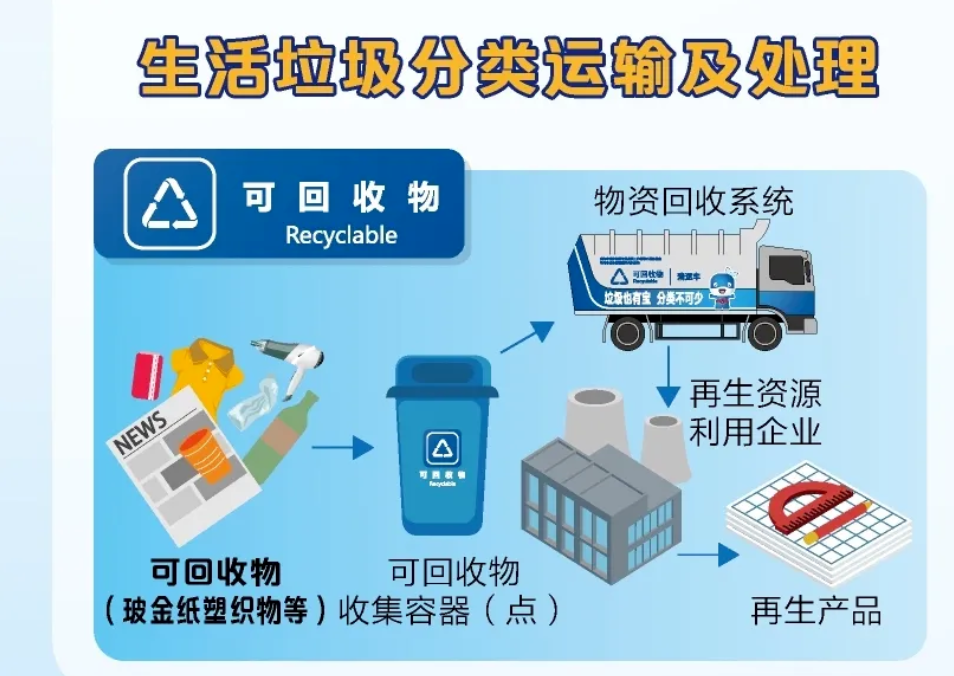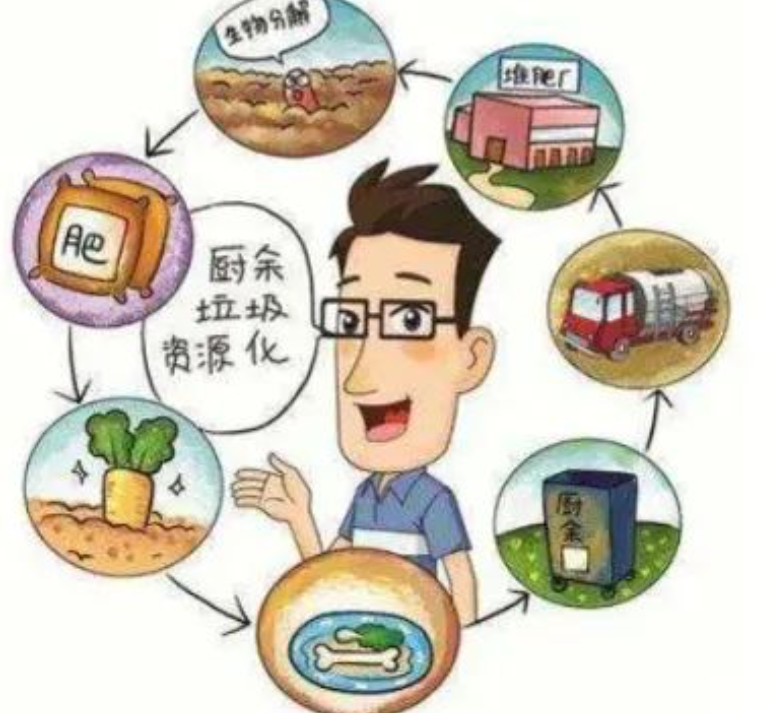After the collection and transportation of household waste, it enters the treatment process. The treatment method for household waste is centralized at the waste treatment plant, and there are different treatment methods based on the classification of waste. However, different treatment methods for household waste can be shared. One treatment method can handle multiple types of waste. Below, we will learn about the methods of garbage classification.

Disposal methods for recyclable materials
1. Garbage recycling method: After garbage is classified, the substances that can be directly used in it are recycled and reused. For example, discarded glass, plastic, metal, paper, newspapers, wood, cloth, waste oil, etc.
2. Garbage incineration power generation method: This is a widely used method in various countries around the world, which can thoroughly disinfect and eliminate pests while turning waste into energy.
3. Garbage composting method: Based on traditional agricultural composting principles, organic waste and soil microorganisms are used to convert waste into organic fertilizer for soil improvement.
4. Garbage biodegradation method: By utilizing a variety of multifunctional and highly degradable bacterial communities, organic and inorganic substances in garbage can be quickly decomposed, making it valuable and fully utilized. According to different bacterial species, it can be further divided into anaerobic degradation and oxidative degradation. It can be seen that the treatment of recyclable waste requires attention to methods, such as sorting the waste and reusing the substances that can be directly used. For example, discarded glass, plastic, metal, paper, newspapers, wood, cloth, waste oil, etc.

Disposal methods for hazardous waste
1. Landfill: For some harmful waste, the method of landfill can be adopted for disposal. Landfill involves digging some pits in advance, then pouring the collected harmful waste into the landfill, and allowing time to slowly decompose these harmful waste.
2. Incineration: To treat some harmful waste, incineration can also be used. However, incineration has a major disadvantage, which is that it can cause significant damage to the environment. However, some harmful waste must also be treated through special incineration, and other methods cannot be used to dispose of it completely. Therefore, incineration must be used to treat some special harmful waste.
3. Special treatment: Some harmful garbage must undergo special disposal procedures, which are complex, but disposal procedures are also necessary because only through these complex procedures can these garbage be successfully decomposed and disposed of, so as not to cause greater pollution to the environment.
4. Composting method: For some special harmful waste, composting can also be used for treatment. The so-called composting is to pile up these harmful waste together for a certain period of time, and then decompose them through the chemical interaction between the waste. The new substances produced can also be used in other places to achieve resource reuse.

Treatment methods for kitchen waste
1. Landfill: Kitchen waste landfill treatment is an anaerobic digestion method that can decompose organic matter into CH4 and completely dispose of the waste. This technology is convenient and does not leave any residue disposal issues.
2. Fertilization treatment: Classify kitchen waste, put it into a kitchen waste crusher, cut it into appropriate sized particles, accelerate the dehydration, oxidation, and degradation of kitchen waste, and then spray anaerobic or aerobic bacteria to avoid problems such as slow composting temperature rise, large odor generation, and inconvenient transportation and mixing due to poor ventilation. Then, put the crushed kitchen waste into the kitchen waste treatment machine from the feeding port, After steps such as stirring, fermentation, and air drying, it can be transformed into granular organic fertilizer.
3. Feed treatment: The feed treatment principle of kitchen waste is to use a large amount of organic matter contained in kitchen waste to crush, dehydrate, ferment, and separate soft and hard materials, and convert the waste into high calorie animal feed, turning it into treasure.
4. Energy based treatment: The energy based treatment of kitchen waste has rapidly emerged in recent years, mainly including incineration, thermal decomposition, fermentation for hydrogen production, etc. The incineration method has a high efficiency in treating kitchen waste, resulting in approximately 5% of the residue from disposal. Incineration is carried out in a specially designed incinerator, and the generated heat energy can be converted into steam or electrical energy, thereby achieving energy recovery and utilization.
5. Microbial treatment: Microbial treatment of kitchen waste refers to the technology of putting safe microbial agents into the waste treatment box, fully mixing and stirring with kitchen waste, and decomposing kitchen waste into water, carbon dioxide, and bioenergy by releasing a large amount of digestive enzymes. During work, microorganisms do not need to be heated, aerobic, and the waste treatment rate exceeds 99.37%. The generated wastewater can be discharged through pipes after testing, and can also irrigate green plants. The microbial strains in the water can improve the soil environment.

Other waste disposal methods
Other waste refers to waste that poses relatively little harm and has no value for reuse, such as construction waste, household waste, etc. It is generally treated by methods such as landfill, incineration, composting, etc. Other waste is a type of waste left over from recyclable materials, kitchen waste, and hazardous waste.
1. Landfill: Landfill is an effective method for consuming a large amount of urban household waste, and it is also the final treatment method for all residual waste from waste treatment processes. Currently, direct landfill is widely used in China. The so-called direct landfill method is to fill garbage into a prepared pit and cover it with compaction, causing it to undergo biological, physical, and chemical changes, decompose organic matter, and achieve the goal of reduction and harmless treatment. The landfill treatment method is the most common waste treatment method, with its main characteristics being low treatment cost and simple method, but it is easy to cause secondary pollution of groundwater resources.
2. Incineration: The incineration method is a method of placing garbage in a high-temperature furnace to fully oxidize the combustible components, and the heat generated is used for power generation and heating. At present, more advanced waste to energy systems can convert waste with a humidity of up to 7% into dry solids for incineration, with an incineration efficiency of over 95%. At the same time, the high temperature on the surface of the incinerator can convert heat energy into steam, which can be used for heating, air conditioning equipment, and steam turbine power generation.
3. Composting: Stacking household waste into piles, holding it at 70 ℃ for storage and fermentation, utilizing the ability of microorganisms in the waste to decompose organic matter into inorganic nutrients. After composting, household waste becomes a hygienic and odorless humus. It not only solves the problem of garbage disposal, but also achieves the goal of re utilization.

The treatment methods for household waste will also develop new treatment technologies based on the development of science and technology. In the final processing stage, there is still a greater need for standardized treatment in the input, collection, and transportation stages. Garbage sorting, collection, and transportation will all provide convenience for the subsequent processing stages.